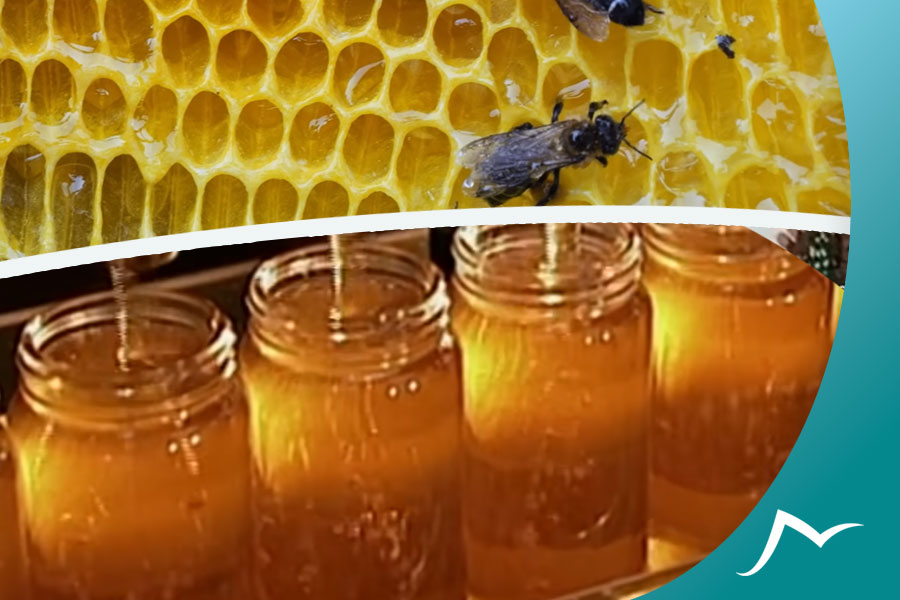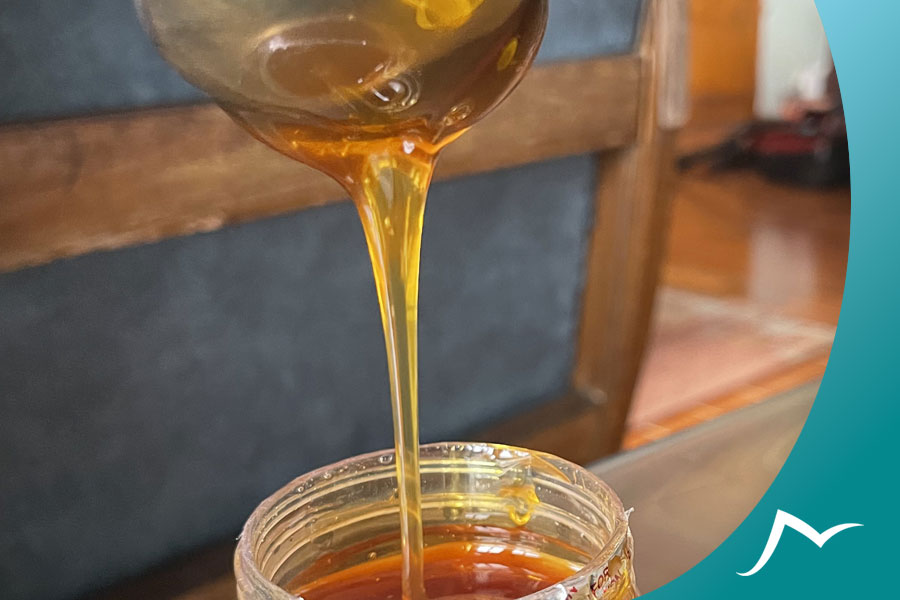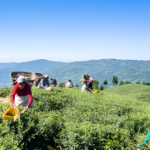Bitter honey, also known as “Deli bal” or “Miele pazzo” in different regions of the world, is a unique and highly sought-after type of Honey with psychedelic properties. It is made by bees who collect nectar from the Rhododendron flowers found in the high-altitude mountains of Nepal. This Honey has gained attention worldwide for its intoxicating properties, which can lead to euphoria and hallucinations but can also have dangerous side effects if consumed in large amounts. In this article, we will delve deeper into Bitter honey of Nepal’s history, effects, and cultural significance.
Bitter honey is produced by bees that collect nectar from the Rhododendron flowers, which contain grayanotoxins, a type of neurotoxin. These toxins can cause hallucinations, dizziness, nausea, and in severe cases, heart problems and death. Despite the potential dangers, Bitter honey has become increasingly popular due to its perceived medicinal and aphrodisiac properties.
Bitter honey has a long history in Nepal, dating back to ancient times when it was used for medicinal purposes, especially in treating digestive problems. Nepalese honey hunters brave the cliffs and high altitudes to collect the Honey, often putting their lives at risk in the process. The Honey is harvested twice a year, in the spring and autumn, and has become an essential source of income for many Nepalese communities.
Bitter honey is vital to Nepalese culture and is deeply ingrained in their traditions and beliefs. It is used in various religious rituals and ceremonies and is believed to have healing properties. Honey is also prized for its unique taste and is often given as a gift or used in cooking.

The Process of Harvesting Bitter honey
Bitter honey is a rare and precious delicacy harvested in Nepal for centuries. This unique type of Honey is known for its psychoactive properties, which are caused by the nectar of the rhododendron flowers that the bees feed on. However, harvesting bitter honey is challenging, as it requires a great deal of skill and knowledge. In this section, we will take a closer look at the process of collecting bitter honey, the regions in Nepal where it is found, and the tools and techniques used for its harvesting.
A detailed explanation of the process of collecting Bitter honey
Harvesting bitter honey involves several steps, each requiring careful attention and skill. First, the beekeepers must locate the hives of the Giant Himalayan Honey Bee, which can be found on high cliffs and in trees in the remote mountainous regions of Nepal. Once the hives are located, the beekeepers prepare for the harvest by building a fire and smoking out the bees from the hive. After the bees have left, the honeycombs are removed and taken back to the village for processing.
The regions in Nepal where Bitter honey is found
Bitter honey is found in the mountainous regions of Nepal, particularly in the central and eastern parts of the country. The Makalu Barun National Park, Dhaulagiri, Langtang, Annapurna, and Kanchenjunga Conservation Area are hotspots for bitter honey harvesting. These regions are characterized by their rugged terrain, cliffs, and dense forests, which provide the ideal habitat for the Giant Himalayan Honey Bee.
The tools and techniques used for Bitter honey harvesting
Harvesting bitter honey requires specialized tools and techniques that generations of beekeepers have perfected. The beekeepers use tools, including long bamboo poles, ropes, and baskets, to reach the high cliffs and trees where the hives are. They also use protective clothing and smoke to avoid being stung by the bees. Once the honeycombs are collected, they are taken back to the village, where they are crushed and filtered to extract the Honey. Collecting and processing bitter honey can take several days and requires a great deal of skill and patience.

Types of Bitter honey in Nepal
Nepal is known for producing some of the world’s finest and purest forms of Bitter honey. Different types of Bitter honey are found in Nepal, each with unique characteristics, taste, and colour. This section will explore the different kinds of Bitter honey in Nepal and their variations.
Explanation of the different types of Bitter honey found in Nepal.
The most popular types of Bitter honey in Nepal are black, red, and white. These different varieties of Bitter honey are harvested from various species of the rhododendron flower, which is native to the Himalayan regions of Nepal. Black Honey is considered the most potent, while white Honey is less powerful and has a milder flavor.
The differences in color, texture, and taste of different types of Bitter honey
The color of Bitter honey varies from light to dark, depending on the species of rhododendron flower used in its production. Black Honey is usually thick and dark, with a strong bitter taste, while red Honey has a lighter texture and a sweet-sour flavor. White Honey is pale in color and has a creamy texture with a sweet and delicate flavor.
The variations in potency and medicinal benefits of different types of Bitter honey
The potency and medicinal benefits of Bitter honey vary depending on the type of Honey. Black Honey is the most potent and is known for its strong hallucinogenic effects. It contains high levels of grayanotoxins, which can cause nausea, dizziness, and even unconsciousness. Red Honey is less potent and is considered a mild hallucinogen. It is believed to have medicinal properties and is used in traditional medicine to treat various ailments such as cough, cold, and digestive disorders. White Honey is the least potent and is not used for its hallucinogenic effects. Instead, it is a natural sweetener with numerous health benefits, including antibacterial and antioxidant properties.
Medicinal Benefits of Bitter honey
Bitter honey is more than just a sweet treat; it has several medicinal benefits. For centuries, Nepalese people have been using Bitter honey to treat various ailments, ranging from digestive issues to wound healing. Its medicinal properties have also caught the attention of modern researchers, who have conducted several studies on its therapeutic effects.
A detailed explanation of the various medicinal benefits of Bitter honey
Bitter honey contains several active compounds, including grayanotoxins, responsible for its therapeutic properties. One of the main benefits of Bitter honey is its antibacterial and antifungal properties. It can help fight off harmful bacteria and fungi, making it helpful in treating infections and promoting wound healing.
In addition, Bitter honey has been found to have anti-inflammatory effects, which can help reduce inflammation and alleviate pain in conditions such as arthritis. It has also been shown to have antiviral properties, which can help treat viral infections such as the common cold.
Scientific research on the medicinal properties of Bitter honey
In recent years, several scientific studies have been conducted on the medicinal properties of Bitter honey. A study published in the Journal of Food and Drug Analysis in 2018 found that Bitter honey had potent antioxidant and antibacterial activities, making it helpful in preventing and treating various diseases. Another study published in Evidence-Based Complementary and Alternative Medicine in 2015 found that Bitter honey had significant wound-healing properties and could help treat diabetic foot ulcers.
The traditional use of Bitter honey in Nepalese medicine
Bitter honey has been used in Nepalese medicine for centuries. It has been used to treat various ailments, including digestive and respiratory problems, and even as an aphrodisiac. It is also used in traditional healing practices such as Ayurveda and Unani medicine. The conventional use of Bitter honey in Nepalese treatment highlights its importance and value in the country’s cultural and medical procedures.

The Dangers of Bitter honey Consumption
Bitter honey may have numerous medicinal benefits, but knowing its potential risks and side effects is essential. The dangers associated with consuming Bitter honey are primarily due to the presence of grayanotoxin, a toxic component that can cause adverse effects on the human body. Grayanotoxin is found in the nectar of Rhododendron flowers that bees use to produce Bitter honey. The toxin is not destroyed during honey processing and can remain active even after the Honey is consumed.
Potential Risks and Side Effects of Consuming Bitter honey
Consuming even a small amount of Bitter honey can cause various side effects. These can range from mild to severe, including dizziness, nausea, vomiting, sweating, blurred vision, irregular heartbeats, and, in extreme cases, loss of consciousness. The symptoms of Bitter honey poisoning can appear within a few minutes to a few hours after ingestion, depending on the amount consumed.
Bitter honey can sometimes interact with prescription medications, causing adverse reactions. People with cardiovascular diseases, low blood pressure, or taking medicines for heart conditions should be particularly cautious when consuming Bitter honey.
Precautions to Take Before Consuming Bitter honey
It is essential to exercise caution and take appropriate precautions before consuming Bitter honey. One of the most necessary precautions is to buy Bitter honey only from trusted sources and reputable beekeepers. It is also essential to start with small amounts and gradually increase the dose to avoid adverse reactions.
Furthermore, people with pre-existing medical conditions or those taking prescription medications should consult a healthcare professional before consuming Bitter honey. Pregnant women and children should avoid consuming Bitter honey altogether.
Cultural Significance of Bitter honey in Nepal
Bitter honey has been an integral part of Nepalese culture for centuries. It is used for its medicinal properties and plays a vital role in traditional practices and religious ceremonies. In this section, we will explore the cultural significance of Bitter honey in Nepal.
Bitter honey in Nepalese Cuisine and Traditional Practices
Bitter honey is widely used in Nepalese cuisine and traditional practices. It is commonly used as a sweetener, flavoring agent, and medicinal ingredient. The unique taste and aroma of Bitter honey make it a favorite ingredient in many dishes. It is also used in Ayurvedic medicine for its various health benefits.
Bitter honey in Religious Ceremonies and Festivals
Bitter honey has a significant role in Nepalese religious ceremonies and festivals. It is often used as an offering to deities, and it is believed that consuming it during religious rituals can bring good luck and fortune. Bitter honey is also used in traditional healing ceremonies by shamans.
Bitter honey as a Symbol of Nepalese Identity
Bitter honey has become a symbol of Nepalese identity, often used to represent Nepal in various cultural events and exhibitions. Honey has gained worldwide recognition due to its unique properties and cultural significance. It has become a source of pride for Nepalese people, who take great pride in their heritage and cultural practices associated with Bitter honey.
The Commercialization of Bitter honey
Bitter honey has gained much attention in recent years, not just for its unique taste and medicinal benefits but also for its potential to boost Nepal’s economy and tourism industry. The demand for Bitter honey has increased significantly in international markets, especially in countries like Japan, China, and Korea, where it is highly valued for its medicinal properties. However, the commercialization of Bitter honey comes with its challenges.
The current state of the Bitter honey industry in Nepal
The Bitter honey industry in Nepal is mainly informal and unregulated. Most of the Bitter honey production is carried out by small-scale beekeepers, who collect Honey from wild bees in remote regions of the country. Due to the lack of proper infrastructure, technology, and market access, most beekeepers cannot sell their Honey at fair prices. As a result, intermediaries and traders often exploit them, paying low prices and reaping most of the profits.
The potential for Bitter honey to boost Nepal’s economy and tourism industry
Bitter honey has the potential to become a significant contributor to Nepal’s economy and tourism industry. The country’s unique geography and climate offer an ideal environment for beekeeping, and Bitter honey is one of the few products that can be produced sustainably in remote areas. By promoting the production and marketing of Bitter honey, Nepal can create employment opportunities for its people, especially in rural areas, and generate income from exports.
The ethical concerns surrounding Bitter honey production and sales
Despite the potential benefits of Bitter honey production, there are ethical concerns regarding its commercialization. One of the main issues is the unsustainable harvesting of wild Honey. Overharvesting can lead to the depletion of bee populations and the destruction of their habitats, which can have severe ecological consequences. Moreover, there are reports of honey hunters using harmful methods to extract Honey, such as burning hives or using chemicals, which can harm both bees and the environment. There are also concerns about the safety and quality of Bitter honey sold in the market, as many products are adulterated or contaminated. Therefore, it is crucial to regulate the production and sale of Bitter honey to ensure that it is harvested sustainably and sold ethically.
FAQs
What is Bitter honey of Nepal?
Bitter honey of Nepal is a type of Honey produced by bees that feed on the nectar of the Rhododendron flowers found in the mountainous regions of Nepal.
What are the effects of Bitter honey?
Bitter honey contains grayanotoxin, which can cause various effects on the human body, including dizziness, nausea, vomiting, and in extreme cases, cardiac arrhythmias and respiratory distress.
What is the process of harvesting Bitter honey?
Harvesting Bitter honey involves locating the hives of bees that feed on the Rhododendron flowers and collecting the honeycomb frames, which are then extracted and processed.
Where is Bitter honey found in Nepal?
Bitter honey is primarily found in the mountainous regions of Nepal, including the Himalayan foothills and the forests of the central and western areas.
What tools and techniques are used for Bitter honey harvesting?
Traditional techniques involve using bamboo ladders, ropes, and baskets to access the hives, while modern methods may include using ropes and harnesses.
What are the different types of Bitter honey found in Nepal?
Several types of Bitter honey are found in Nepal, including black, red, and white varieties.
What are the differences in taste and texture between different types of Bitter honey?
Different types of Bitter honey have varying degrees of sweetness and various textures, including thick and syrupy to thin and runny.
What are the medicinal benefits of Bitter honey?
Bitter honey has been used for centuries in Nepalese medicine as a natural remedy for various conditions, including wound healing, digestive issues, and respiratory problems.
What scientific research has been conducted on the medicinal properties of Bitter honey?
Research has shown that Bitter honey contains various bioactive compounds, including antioxidants and antimicrobial agents, which may contribute to its potential therapeutic effects.
How is Bitter honey consumed?
Bitter honey is typically consumed in small quantities as a sweetener or a traditional remedy for various ailments.
What is the price for Bitter honey in Nepal?
The price of Bitter honey in Nepal varies depending on the quality and location. It can range from 500 to 3000 Nepalese Rupees (NPR) per kilogram. However, some high-quality Bitter honey can be sold for as much as 10,000 NPR per kilogram.
What are the potential risks and side effects of consuming Bitter honey?
Consuming too much Bitter honey can lead to various side effects, including dizziness, nausea, vomiting, and in extreme cases, cardiac arrhythmias and respiratory distress.
What precautions should be taken before consuming Bitter honey?
Individuals should consult with their healthcare provider before consuming Bitter honey, particularly if they have a history of heart or respiratory problems.
What is the cultural significance of Bitter honey in Nepal?
Bitter honey plays a vital role in Nepalese cuisine and traditional practices, as well as in religious ceremonies and festivals.
What is the current state of the Bitter honey industry in Nepal?
The Bitter honey industry in Nepal is relatively tiny, but it has the potential to grow and contribute to the country’s economic and tourism development.
What are the ethical concerns surrounding Bitter honey production and sales?
There are concerns about the sustainability of Bitter honey production and the potential exploitation of local communities involved in the harvesting and processing of the Honey.
Conclusion
In conclusion, the Bitter honey of Nepal is a unique and fascinating substance that has played a significant role in Nepalese culture for centuries. Its medicinal properties, cultural significance, and potential economic benefits have made it a topic of interest for people worldwide. However, it is essential to consume Bitter honey responsibly, as the toxic component can have serious side effects. It is also crucial to preserve the traditional methods of Bitter honey harvesting and production to maintain its cultural significance and ensure the industry’s sustainability.
As Nepal continues to develop its economy and promote its tourism industry, Bitter honey has the potential to become an asset. However, this must be done responsibly and ethically to prevent exploitation and to preserve the cultural integrity of Bitter honey’s production. As consumers, we must also be aware of the impact of our consumption on the environment and the people involved in industry.
Overall, the Bitter honey of Nepal is a fascinating subject that deserves attention and respect. It’s unique properties and cultural significance make it an asset to Nepal’s heritage and economy. By understanding and appreciating Bitter honey, we can benefit from its medicinal properties and contribute to Nepalese culture’s preservation and sustainability.



